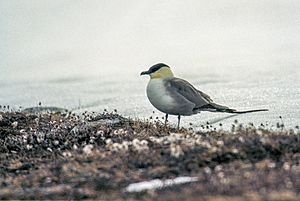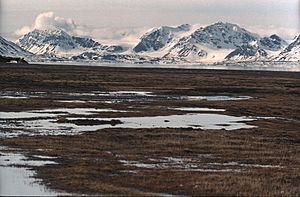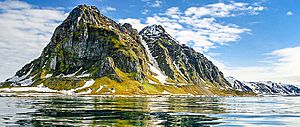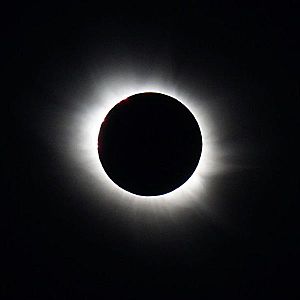Svalbard facts for kids
Quick facts for kids
Svalbard
|
|
|---|---|
|
|
|
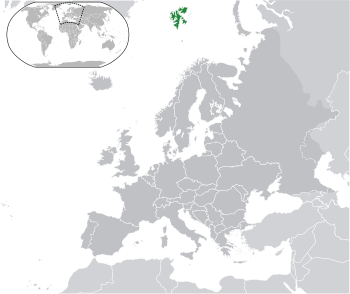 |
|
| Capital and largest city
|
Longyearbyen |
| Official languages | Norwegian |
| Ethnic groups | |
| Government | Region of Norway |
|
• Governor
|
Odd Olsen Ingerø (2009–) |
| Area | |
|
• Total
|
61,022 km2 (23,561 sq mi) |
| Population | |
|
• 2012 estimate
|
2,642 |
| Currency | Norwegian krone (NOK) |
| Time zone | UTC+1 (CET) |
|
• Summer (DST)
|
UTC+2 (CEST) |
| Calling code | +47 |
| Internet TLD | .no a |
|
|
Svalbard is a group of islands located far north in the Arctic Ocean. It's the northernmost part of Norway, located about halfway between mainland Norway and the North Pole. The largest island is Spitsbergen, followed by Nordaustlandet and Edgeøya.
The islands are managed by the Governor of Svalbard, whose office is in Longyearbyen. Other places where people live include research stations, a Russian mining town called Barentsburg, a research community in Ny-Ålesund, and a mining outpost in Sveagruva.
Svalbard was first used in the 1600s and 1700s as a base for whaling. After that, it was left empty for a while. Coal mining began in the early 1900s, leading to the creation of permanent villages. The Svalbard Treaty of 1920 gave Norway control over Svalbard. In 1925, the Svalbard Act officially made Svalbard part of Norway. These agreements also allow people to do business freely and state that no military activities can happen there. Today, there are only two main mining companies, one Norwegian and one Russian. Research and tourism are also very important activities.
There are no roads connecting the different towns. People travel by snowmobiles, planes, and boats. Svalbard Airport in Longyearbyen is the main airport.
In summer, the plants grow quickly because of the midnight sun, when the sun never sets. Svalbard is a home for many seabirds. You can also find polar bears, reindeer, and mammals that live in the sea. To protect this special environment, two-thirds of Svalbard is covered by seven national parks and 23 nature reserves. Most of the land, about 60%, is covered by glaciers, and the islands have many mountains and fjords.
During the 2019–20 coronavirus pandemic, Svalbard was one of the few places in Europe not affected by the COVID-19 pandemic.
Contents
Understanding Svalbard's Climate
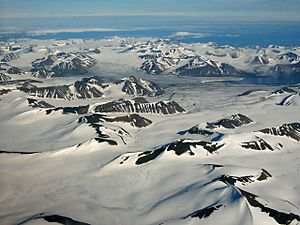
Svalbard has an Arctic climate, but it's made a bit milder by the North Atlantic Current. The Nordenskiöld Land area is the warmest and wettest. This happens because warm, moist air from the south meets cold air from the north.
In summer, the average high temperatures are usually between 3 and 7 degrees Celsius (37 to 45 degrees Fahrenheit). In winter, average highs are around -11 to -13 degrees Celsius (8 to 12 degrees Fahrenheit).
Sun and Snow in Svalbard
Svalbard experiences the midnight sun from April 19 to August 23. This means the sun never sets during this period. The polar night lasts from October 27 to February 14, when the sun never rises. Because of the mountains, the sun isn't visible in Longyearbyen until around March 8. Snow usually covers the town from November through March.
The warmest temperature ever recorded in Svalbard was 25.0 degrees Celsius (77.0 degrees Fahrenheit) in July 1977. The coldest was -46.3 degrees Celsius (-51.3 degrees Fahrenheit) in March 1986. Even with its very northern location, Svalbard has recorded temperatures above freezing in every month of the year. For example, in February 2012, mild temperatures affected both people and wildlife. The climate here is warming very quickly. Also, it has never been below freezing in July.
Bjornoya (Bear Island) gets the least sunshine in Europe, with only 595 hours per year. Longyearbyen, further north, gets almost twice as much sunshine.
How Svalbard Makes Money
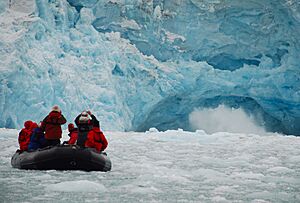
The three main ways Svalbard makes money are coal mining, tourism, and research.
Coal Mining in Svalbard
Since people started living in Svalbard again in the early 1900s, coal mining has been the most important business. The Norwegian company Store Norske Spitsbergen Kulkompani runs mines in Sveagruva and Longyearbyen. In 2008, the Sveagruva mine produced 3.4 million tonnes of coal. The mine in Longyearbyen uses 35% of its coal to power the Longyearbyen Power Station.
The Russian company Arktikugol in Barentsburg hasn't done much mining since 2007. People have tried drilling for oil on land before, but it wasn't successful enough to continue. The Norwegian government does not allow oil drilling offshore to protect the environment. Areas where drilling was tested are now protected as nature reserves or national parks.
Tourism and Research
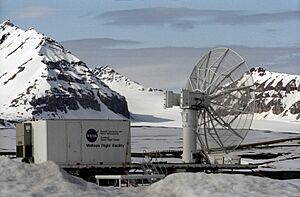
Tourism in Svalbard focuses on its amazing natural environment, mostly around Longyearbyen. Fun activities include hiking, kayaking, exploring glacier caves, and going on snowmobile or dog-sled safaris. Many visitors come on cruise ships. Tourism is busiest between March and August. The number of overnight stays has grown a lot, from 1991 to 2008.
Svalbard is also a hub for important research. The Svalbard Global Seed Vault is a special place that stores seeds from all over the world. It's like a backup for plants in case something happens to crops elsewhere. The vault is built into a rock near Longyearbyen. It naturally stays at -6 degrees Celsius (21 degrees Fahrenheit), and the seeds are kept even colder at -18 degrees Celsius (0 degrees Fahrenheit).
The Svalbard Undersea Cable System is a 1,440-kilometer (890-mile) long optical fiber cable that connects Svalbard to Norway. This cable is needed for communicating with satellites that orbit over the poles, through the Svalbard Satellite Station and research facilities in Ny-Ålesund.
Amazing Nature and Wildlife
Besides humans, Svalbard is home to three main land mammals: the Arctic fox, the Svalbard reindeer, and small southern voles found only in Grumant. Attempts to bring in Arctic hares and muskoxen have not worked. There are also 15 to 20 types of marine mammals, including whales, dolphins, seals, walruses, and polar bears.
Polar Bears: Svalbard's Icon
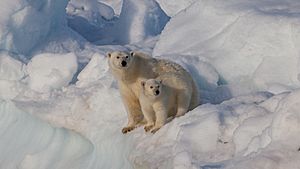
Polar bears are the most famous symbol of Svalbard and a big reason why tourists visit. These animals are protected. People who go outside the towns must carry special devices to scare bears away. They are also advised to carry a firearm as a very last resort for safety. Svalbard and Franz Josef Land share a population of about 3,000 polar bears. Kong Karls Land is a very important place where they have their babies.
Other Animals and Birds
The Svalbard reindeer is a special type of reindeer found only here. Even though they were once almost gone, you can now legally hunt them (and Arctic foxes). There are also a few farm animals in the Russian settlements.
About 80 types of birds live in Svalbard, and most of them migrate there for part of the year. The Barents Sea has one of the largest populations of seabirds in the world, with about 20 million birds in late summer. Common birds include the little auk, northern fulmar, thick-billed murre, and black-legged kittiwake. Sixteen bird species are on the IUCN Red List, meaning they are at risk. Places like Bjørnøya, Storfjorden, Nordvest-Spitsbergen, and Hopen are important breeding spots for seabirds.
The Arctic tern travels the furthest of any bird, all the way to Antarctica. Only two songbirds, the snow bunting and the wheatear, come to Svalbard to breed. The rock ptarmigan is the only bird that stays through the winter. Scientists have also found remains of a huge ancient marine reptile called Predator X (Pliosaurus funkei) from the Jurassic period here.
Plants and Landscapes
Svalbard has permafrost (ground that is always frozen) and tundra, with different types of Arctic plants. About 165 kinds of plants have been found on the islands. Only areas that thaw in the summer have plants, which is about 10% of Svalbard. Plants grow best in Nordenskiöld Land, around Isfjorden, and where bird droppings (guano) enrich the soil. Even though there isn't much rain, plants get enough water because the cold climate reduces how much water evaporates. The growing season is very short, sometimes only a few weeks long.
Svalbard has seven national parks: Forlandet, Indre Wijdefjorden, Nordenskiöld Land, Nordre Isfjorden Land, Nordvest-Spitsbergen, Sassen-Bünsow Land and Sør-Spitsbergen. There are also 15 bird sanctuaries, one protected geological area, and six nature reserves. The Nordaust-Svalbard Nature Reserve and Søraust-Svalbard Nature Reserve are both larger than any of the national parks. Most of these protected areas were created in 1973, with others added in the 2000s. All human traces from before 1946 are automatically protected. In total, protected areas cover 65% of Svalbard. Norway has suggested Svalbard to be a UNESCO World Heritage Site.
A total solar eclipse of March 20, 2015 was only visible from Svalbard and the Faroe Islands. Many scientists and tourists came to observe this amazing event.
Images for kids
-
The whaling station of the Amsterdam chamber of the Northern Company in Smeerenburg, by Cornelis de Man (1639), based on a painting by A.B.R. Speeck (1634).
-
Company homes in Longyearbyen.
-
Snowmobiles are an important mode of transport in Svalbard, such as here at Longyearbyen.
See also
 In Spanish: Svalbard para niños
In Spanish: Svalbard para niños




